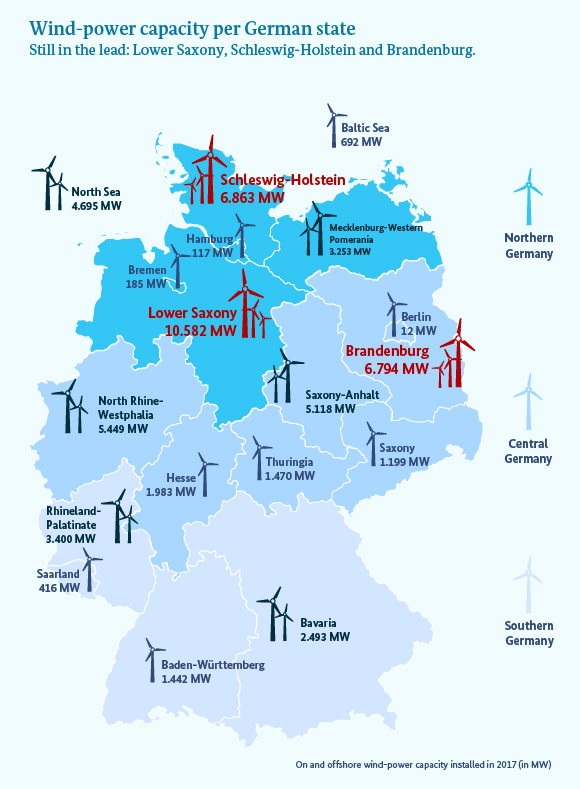A fresh boost for the energy transition
29,844 – that’s the number of on and offshore wind-powered installations in Germany as of 2017. It’s 1,622 more than in the preceding year. Germany’s total wind power capacity now exceeds 50,000 megawatts onshore and 5,000 megawatts offshore.
 © BMWi, Data from: Deutsche WindGuard GmbH, last updated: 31 December 2017
© BMWi, Data from: Deutsche WindGuard GmbH, last updated: 31 December 2017
Onshore wind power reigns supreme: it is by far the most important source of renewable energy in Germany, at a capacity of 50,000 megawatts (MW) at the end of 2017. This represents an impressive increase year-on-year. In 2017, the rate at which new capacity was being added (gross addition) soared up 15 per cent. That’s an all-time high! There are now 28,675 onshore wind turbines in Germany, which is 1,405 more than at the end of 2016. Offshore, particularly in the North Sea, there are now 1,169 wind turbines generating electricity – an increase of 222 over the preceding year.
Onshore wind: Lower Saxony in the lead
Lower Saxony defends its position as the German state with the most onshore capacity (currently 10,582 MW). That’s more than a fifth of Germany’s overall onshore wind power capacity. In second place is Schleswig-Holstein with 6,863 MW, closely followed by Brandenburg with 6,794 MW. Lower Saxony was again also the state that added the most new capacity year-on-year, accounting for almost 27% of all of the onshore capacity constructed in Germany last year. North Rhine-Westphalia also created a large amount of new capacity last year. It accounted for 16 per cent of Germany’s new onshore capacity, putting it in second place. There are now 3,630 wind-powered installations operating in North-Rhine Westphalia, with a combined capacity of almost 5,500 MW. When it comes to total installed onshore capacity, North-Rhine Westphalia is now in fourth place, relegating Saxony-Anhalt into fifth.
Offshore wind: North Sea tops Baltic Sea by a wide margin
There are 997 offshore wind-powered installations with a combined capacity of 4,695 MW in the North Sea, putting it a cut above the Baltic Sea, whose combined capacity from its 172 installations totals 692 MW. This means that 87 per cent of Germany’s offshore installations are located in the North Sea, with the remaining 13 per cent in the Baltic Sea. The amount of new capacity created in the North Sea last year also clearly exceeds that of the Baltic Sea, with 897 MW compared to 354 MW.
Central Germany is Germany’s onshore powerhouse
Central Germany is the region boasting the largest share of onshore wind installations in Germany. Together, North-Rhine Westphalia, Thuringia, Saxony, Saxony-Anhalt, Brandenburg and Berlin account for 43.4 per cent of Germany’s total capacity. This compares to a slightly smaller share of 41.4 per cent of Germany’s total capacity in Germany’s northern states (Lower Saxony, Schleswig-Holstein, Mecklenburg-Western Pomerania, Bremen and Hamburg).
The south is catching up
Southern Germany uses a lot of solar power. The capacity of its wind-powered installations, however, is comparatively small, with Rhineland-Palatinate, Saarland, Baden-Württemberg and Bavaria accounting for a mere 15.3 per cent of Germany’s total. This represents a slight increase of 0.6 percentage points, at the expense of the two other regions which each have lost 0.3 percentage points. The figures show just how necessary it is to build strong power lines connecting the north with the south, not least so that the wind power generated in the north can be distributed across the whole of Germany. In his policy statement, the new Federal Minister for Economic Affairs and Energy, Peter Altmaier, said: “The energy transition will succeed if we make progress on grid expansion. This is why I want to speed this up.”
Repowering – Replacing old wind-powered installations with better ones
Every year, some onshore wind-powered installations are of course dismantled or decommissioned. In 2017, this happened exactlty 387 times. There are various reasons why this may happen. Installations may have reached the end of their operating life or they may be subject to repowering. This is a process that involves existing installations being replaced with more modern ones that operate in the same location, but can generate much more electricity in a more efficient way. This can be seen from the average performance of old and new installations: the installations that have been dismantled had an average capacity of 1,200 kilowatts, compared to more than 3,000 for the new ones. In 2017, 315 repowered installations began their operating life.
These figures for 2017 were provided by German WindGuard GmbH, the company commissioned by Arbeitsgemeinschaft Offshore-Windenergie, the WindEnergie association, the Offshore Wind Energy Foundation, the WAB agency, and VDMA Power Systems to provide data on Germany’s on and offshore capacity every six months. Furthermore, the Onshore Wind Energy Agency used the register of facilities populated by the Bundesnetzagentur to find out about the number of wind turbines that were newly installed in 2017. Whilst the results of the two studies are close, the slightly different methods used have resulted in minor differences in the findings.

